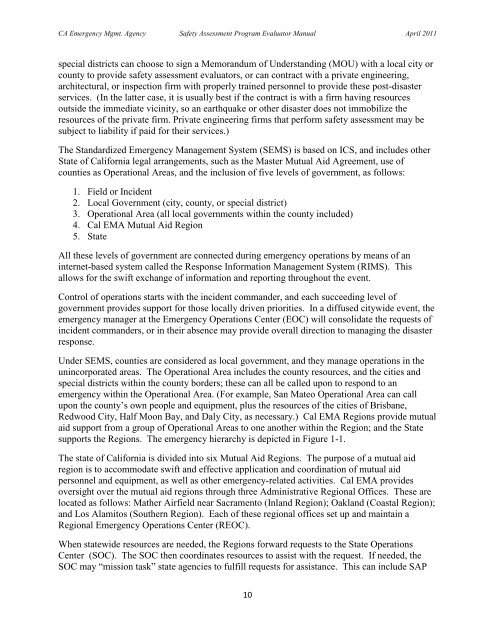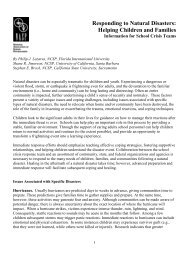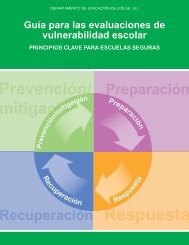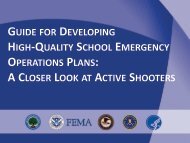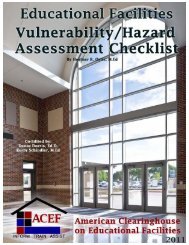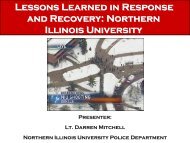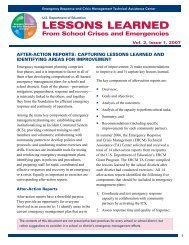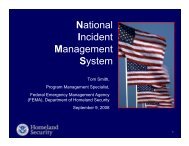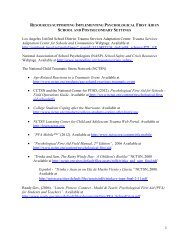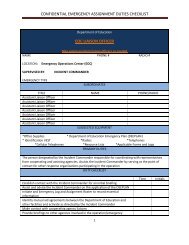Safety Assessment Program Evaluator Student Manual
Safety Assessment Program Evaluator Student Manual
Safety Assessment Program Evaluator Student Manual
You also want an ePaper? Increase the reach of your titles
YUMPU automatically turns print PDFs into web optimized ePapers that Google loves.
CA Emergency Mgmt. Agency <strong>Safety</strong> <strong>Assessment</strong> <strong>Program</strong> <strong>Evaluator</strong> <strong>Manual</strong> April 2011special districts can choose to sign a Memorandum of Understanding (MOU) with a local city orcounty to provide safety assessment evaluators, or can contract with a private engineering,architectural, or inspection firm with properly trained personnel to provide these post-disasterservices. (In the latter case, it is usually best if the contract is with a firm having resourcesoutside the immediate vicinity, so an earthquake or other disaster does not immobilize theresources of the private firm. Private engineering firms that perform safety assessment may besubject to liability if paid for their services.)The Standardized Emergency Management System (SEMS) is based on ICS, and includes otherState of California legal arrangements, such as the Master Mutual Aid Agreement, use ofcounties as Operational Areas, and the inclusion of five levels of government, as follows:1. Field or Incident2. Local Government (city, county, or special district)3. Operational Area (all local governments within the county included)4. Cal EMA Mutual Aid Region5. StateAll these levels of government are connected during emergency operations by means of aninternet-based system called the Response Information Management System (RIMS). Thisallows for the swift exchange of information and reporting throughout the event.Control of operations starts with the incident commander, and each succeeding level ofgovernment provides support for those locally driven priorities. In a diffused citywide event, theemergency manager at the Emergency Operations Center (EOC) will consolidate the requests ofincident commanders, or in their absence may provide overall direction to managing the disasterresponse.Under SEMS, counties are considered as local government, and they manage operations in theunincorporated areas. The Operational Area includes the county resources, and the cities andspecial districts within the county borders; these can all be called upon to respond to anemergency within the Operational Area. (For example, San Mateo Operational Area can callupon the county‟s own people and equipment, plus the resources of the cities of Brisbane,Redwood City, Half Moon Bay, and Daly City, as necessary.) Cal EMA Regions provide mutualaid support from a group of Operational Areas to one another within the Region; and the Statesupports the Regions. The emergency hierarchy is depicted in Figure 1-1.The state of California is divided into six Mutual Aid Regions. The purpose of a mutual aidregion is to accommodate swift and effective application and coordination of mutual aidpersonnel and equipment, as well as other emergency-related activities. Cal EMA providesoversight over the mutual aid regions through three Administrative Regional Offices. These arelocated as follows: Mather Airfield near Sacramento (Inland Region); Oakland (Coastal Region);and Los Alamitos (Southern Region). Each of these regional offices set up and maintain aRegional Emergency Operations Center (REOC).When statewide resources are needed, the Regions forward requests to the State OperationsCenter (SOC). The SOC then coordinates resources to assist with the request. If needed, theSOC may “mission task” state agencies to fulfill requests for assistance. This can include SAP10


